Posted: September 5th, 2012 | Author: Malla Poikela | Filed under: Compelling Cases | Tags: billing, Communications Service Provider, Compelling Cases, Comptel, CSP, European, fulfillment, mediation, Network, Southern Europe, Subscribers, transactions, unified platform | No Comments »
Last week, we introduced our new blog post series, Compelling Cases, where we showcased a Southern European operator looking to stimulate growth and accelerate revenue generation. With the help of Comptel Fulfillment, the operator was able to implement a more productive service delivery process. Continuing on with our series showcasing Comptel in action, today we look at another major European operator that drastically simplified its network complexity and gained significant cost savings with Comptel Convergent Mediation
Context
As is the case with many communications service providers (CSPs), while experiencing mobile subscriber growth this leading European CSP was also faced with more network transactions that needed to be gathered and converted into billable records. In particular, the CSP was seeking a solution that would allow it to more easily manage the collection and transformation of network billing transactions from its five operating companies with various network types. To accomplish this, the CSP turned to Comptel Convergent Mediation.
Conversion
With Comptel’s Convergent Mediation, the CSP was able to harness its multiple networks into one unified platform where billing records from more than 40 million subscribers is now being efficiently processed – making for the largest single subscribers’ billing records processing system in Europe. Running on Linux-based hardware, Comptel’s solution is highly scalable so that the CSP can manage billions of events per day. And, the CSP now has the processing power to enable future growth with LTE transactions.
Completion
This complex mediation consolidation project was delivered in phases: The first phase was finalised in Q4 2011, within the same year that the contract was closed (Q1 2011). The completion of the second phase of the delivery project occurred in Q1 2012 and set the precedent for handling several billions of billing records generated by millions of subscribers in a single mediation system on daily basis.
Visit our website to view this announcement, or see more third-party validated case studies, visit TechValidate-Comptel Solutions
Posted: July 17th, 2012 | Author: Ulla Koivukoski | Filed under: Industry Insights | Tags: analytics, big data, CIQ4T, communications service providers, Comptel, contextual intelligence, customer experience, Heavy Reading, Making Data Beautiful, OSS, real-time, Subscribers, Telcos | 1 Comment »
At Comptel, making data beautiful means transforming the voluminous amounts of information that service providers have on hand into contextual – and digestible – insight. This entails moving beyond the simple collection of data and discovering the true applications of the information.
Heavy Reading analysts Ari Banerjee and Sarah Wallace recently discussed this very topic, exploring how contextual intelligence for telecoms (CIQ4T) can elevate the customer experience through many dimensions. In this conversation, they consider how, in order to fully maximise business opportunities, communications service providers require a holistic understanding of an individual subscriber’s usage patterns, behaviours and circumstances – and the benefits this provides. You can listen to the full podcast of the conversation here or read the highlights, from part one of our two-part series, below.
Ari Banerjee: Sarah, how do you define CIQ4T especially when it comes to dealing with the communications industry and telcos?
Sarah Wallace: CIQ4T is defined as being able to understand the uniqueness of a person, circumstance or object and converting that understanding into an opportunity. That translates very well into telecoms because providers are really trying to get a better understanding of their subscribers and then translate this into an opportunity to retain customers and further monetise their opportunities with them.
Ari Banerjee: Obviously advanced analytics plays a major catalyst role here. In our opinion, advanced analytics is a key enabler for CIQ4T. It helps to navigate through the huge amounts of data that operators gather to get a more in-depth profile of the subscriber and understand factors, like their preferences and usage patterns. Then, service providers can use that data with advanced algorithms to predict future behavior patterns.
Advanced analytics implementation typically involves the creation of architecture that enables the collection, storage and integration of data sets from a variety of systems. Then, applying correlation and analytic techniques to identify patterns of significance across these data sets. Obviously, this helps to provide a root-cause analysis and to become more predictive. On top of that, all of these different processes or ways of handling Big Data help to facilitate the delivery of actionable intelligence and provide context-specific insight for end-users.
So Sarah, now that you’ve defined CIQ4T, can you talk about its key characteristics that you see in your research with service providers today?
Sarah Wallace: Sure. So in telecoms, one key aspect is the real-time capability – or being able to take all the data, process it and turn that into analysis to make offerings in real-time. And then you have the characteristic of prediction – or being able to predict subscriber behavior and allowing for optimal decision-making, when it comes to planning and designing for future offers. There’s also connecting with the customer at all touch points and having a contextual or deeper, granular understanding of those touch points to determine which action should take place next.
Of course, there’s also the ability to handle large volumes of data – for instance, combining the data from the network with other sources, such as CRM and OSS and other network elements. Then, being able to apply that data for real-time decision-making. There’s also the operational aspect of advanced analytics and CIQ4T, which based on the analytics, determines the need for action toward the customer, network and the feedback loop for machine learning.
Ari Banerjee: So what you’re talking about is being able to navigate through Big Data to provide a more predictive pattern of how someone, a network, or the subscriber will behave in the future and to understand the different parameters that make up a subscriber profile. This includes things, like his location, his action patters, and business life, how he’s using services during office hours, non-peak hours, family time – and how to basically provide more offers that are very focused on his day-to-day needs. This is a shift away from mass-market approach of campaign management to more of a focused, one-to-one approach.
Stay tuned for part two, in which Ari Banerjee and Sarah Wallace put analytics into action and discuss compelling CIQ4T use-cases that illustrate just how effective the approach can be.





